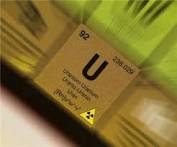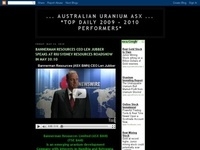Published on Sunday April 01 2012 (AEST)

If you have any plans to enlarge your uranium interests - and you have either ready cash or still know a bank that is lending - this may be the time to go about it. Uranium spot prices continue to be subdued: they remained unchanged this week at $52/lb.
For all the hand-wringing in Japan and Western Europe over nuclear power, the nuclear trajectory is upward. In terms of gigawatt hours, China’s reactor capacity is going to rise from about 10GW 2008 to about 120GW by 2035; India will rise from about 5GW now to 25GW in 2035, Russia from 25GW to 50GW, while projections are that even Europe and the Americas will see increases over the next 23 years. (The numbers are not exact - they are taken from a bar chart - but they at least give some idea of the proportion of growth.
Today the Namibian government has approved the possible $2.2 billion takeover of Australian-listed Extract Resources which owns the Husab uranium mine in that country. This mine is shaping up to be the fourth largest uranium operation in the world. Such a takeover is the expected consequence from the currently occurring acquisition of London-listed Kalahari Minerals, which owns 42.7 per cent of Extract Resources. The buyer is China Guangdong Nuclear Power Corp - which has just started placing orders in Australia for uranium shipments in Shanghai through its Australian owned Energy Metals (which controls the advanced Biglyri uranium deposit in the Northern Terrtory).
We have recently seen the acquisition of Canada’s Hathor Exploration. This has already led to speculation that Hathor’s buyer, Rio Tinto, might next turn its attention to another Canadian company, Fission Energy Corp, which is due to begin drilling at its neighbouring Waterbury Lake project in Canada. Analysts have made the point that the Fukushima disaster, the German retreat from nuclear power, and not to forget the general equity mark weakness, have made uranium stock prices cheap - and companies available at potentially bargain basement prices.
There will also be opportunities for those seeking uranium security. We have just seen Korea Resources Corp team up with Australian junior East Africa Resources to help finance the Mkuju South uranium project in Tanzania. (Incidentally, a Seoul-based utility, Korea Electric Power, is in joint venture with Fission Energy mentioned above.)
There’s also another point in parallel to one I reported about yesterday on our sister blog, Potashblog.com in relation to fertilizer producers, in that during times of financial stress it will be the global diversified miners who have the resources to buy when companies are priced cheaply. Of course, in the case of uranium (and most resources) the Chinese have seemingly limitless amounts of foreign reserves with which to snap up bargains.
In Rio’s case, it is probably still regretting the financial crisis that forced it to sell a number of projects including its potash interests. With uranium, it will also be looking for replacement capacity for the eventual wind down of its Ranger mine in Australia and Rossing mine in Namibia - apart from any potential it may see in actually expanding its uranium operations. (By the way, this is supposition: I may hold shares in Rio Tinto - disclosure thus made - but know nothing more than any other outsider.)
But it does seem clear that anyone with the deep pockets and an urge to expand uranium capacity will be looking to act now rather for uranium prices to tick up again - as they will when more capacity nears completion and Fukushima memories fade - and Europe perhaps sees the folly of its anti-nuclear way.
 Australian Uranium News - Research
Australian Uranium News - Research


Thank you for great posting i have more information Mitsubishi
ReplyDeleteThanks so much for the work you have put into this post..Everything is very open and very clear explanation of issues. was truly information.
ReplyDelete